patterns >  María Jesús Camus's Ravelry Store
María Jesús Camus's Ravelry Store
> Margarita

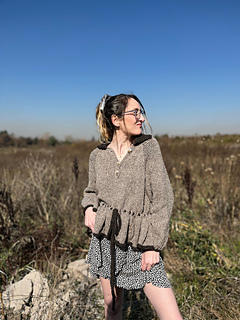
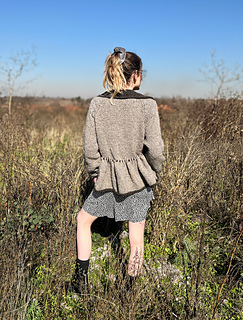
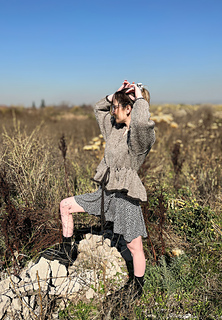
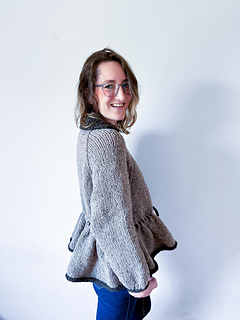
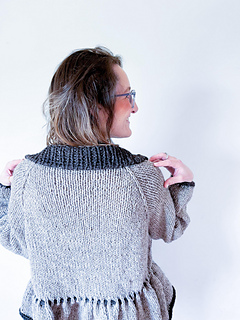
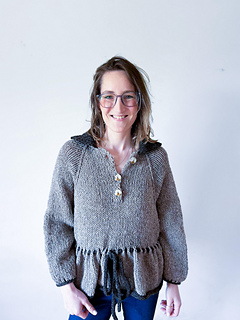
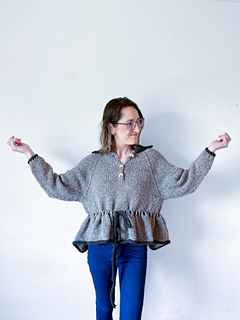
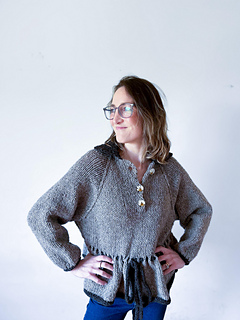
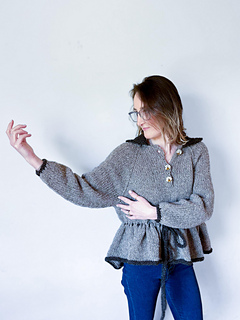
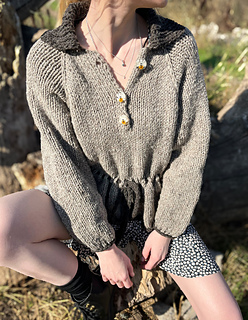
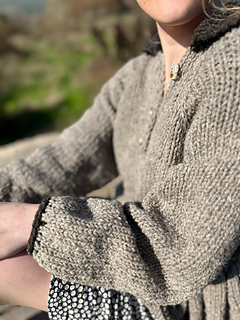
Margarita
ENGLISH
About the pattern
This sweater is worked from the top down, back and forth at the first and then in the round. Raglan increases are worked while buttonholes are made for the collar flap, which is then joined with a three-needle bind-off. The body is continued in the round following the raglan increases. The body and sleeves are separated and worked in the round one by one. Increases are made on the body to create a ruffle, while holes are made to thread a cord through the middle body. The body is closed with an i-cord bind-off. The sleeves are worked with progressive decreases and then a drastic round of decreases is worked to create a semi-balloon sleeve effect. The cuffs are closed with an i-cord cast-off. Finally, stitches for the collar are picked up a ribbed polo-style collar is worked, with a tubular bind-off.
DETAILS
Sizes: 1, 2, 3 (4, 5, 6) 7, 8, 9 equivalent to 157, 163, 179 (190, 201, 227) 237, 253, 269 cm of bust circumference (finished measurements) with 60 - 70 cm of positive ease.
Gauge: 11 sts & 16 rows = 10 cm on larger needles. Measured over stockinette stitch after blocking.
Yarn:
Yarn A: About 1010 1120, 1230 (1346, 1455, 1627) 1736, 1840, 1960 meters of worsted weight yarn. Sample: 100% Chilean Corriedale wool, worsted weight; 150 mt per 100 g. natural color.
Yarn B: About 95, 100, 110 (125, 140, 150) 165, 180 210 meters of worsted yarn. Sample: 100% Chilean Corriedale wool, worsted weight; 150 mt per 100 g. natural color.
Needles:
Recommended needles (to get gauge):
8.0 mm circular needles with a cable of 80 - 100 cm for the body.
8.0 mm DPNs or short circular needles or circular needles with a cable length appropriate for magic loop for sleeves.
Notions:
Stitch markers, stitch holders (or scrap yarn), a third 8.0 mm needle to work the collar join, tapestry needle (to weave ends), 3 buttons of about 10 mm, mats and pins for blocking.
ESPAÑOL
Sobre el patrón
Este sweater se trabaja de arriba hacia abajo, de ida y vuelta al principio y uego en redondo. Se trabajan aumentos de raglán mientras se hacen ojales para la solapa del cuello, que luego se une con un remate de tres agujas. El cuerpo se continúa en redondo siguiendo los aumentos de raglán. El cuerpo y las mangas se separan y se trabajan en redondo uno por uno. Se hacen aumentos en el cuerpo para crear un volante, mientras que se hacen agujeros para pasar un cordón a través del cuerpo central. El cuerpo se cierra con un remate de cordón o i-cord. Las mangas se trabajan con disminuciones progresivas y luego se trabaja una ronda drástica de disminuciones para crear un efecto de manga semi-globo. Los puños se cierran con un remate de cordón o i-cord. Finalmente, se levantan los puntos para el cuello y se trabaja un cuello en punto elástico estilo polo, que se cierra con un remate tubular.
DETALLES
Tallas: 1, 2, 3 (4, 5, 6) 7, 8, 9 equivalente a 157, 163, 179 (190, 201, 227) 237, 253, 269 cm de circunferencia de busto (medidas finales) con 60 - 70 cm de holgura positiva. Mostrado en talla 2 en un cuerpo con 93 cm de contorno de busto y 70 cm de holgura positiva
Muestra: 11 p & 16 vtas = 10 cm. Medido sobre punto jersey, post bloqueo.
Hilado:
Hilado A:
Aprox 1010 1120, 1230 (1346, 1455, 1627) 1736, 1840, 1960 metros de grosor worsted. Original: 100% lana Corriedale chilena, grosor worsted 150 mt en 100 g. Color natural.
Hilado B: Aprox 95, 100, 110 (125, 140, 150) 165, 180 metros de hilado grosor worsted. Original. 100% lana Corriedale chilena, grosor worsted 150 mt en 100 g. Color natural.
Agujas:
Agujas recomendadas (para conseguir la muestra):
Agujas circulares de 8.0 mm con un cable de of 80 - 100 cm para el cuerpo.
Agujas de doble punta o agujas circulares cortas o con un cable lo suficientemente largo como para trabajar magic loop, para las mangas.
Otros:
Marcadores de punto, sostenedores de punto (o hilado de desecho), una tercera aguja de 8.0 mm para trabajar la unión del cuello, aguja de lana (para rematar hebras), 3 botones de aprox 10 mm, mats y pines de bloqueo.
- First published: August 2025
- Page created: August 20, 2025
- Last updated: August 20, 2025 …
- visits in the last 24 hours
- visitors right now




